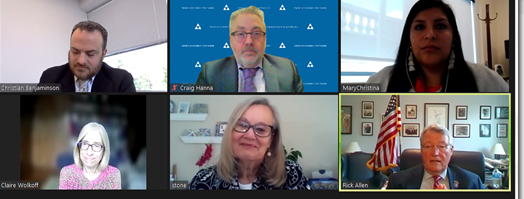The Retirement Report, Summer-Fall 2021
Vol 4 | No. 3
Q&A—Multiemployer Plans and the American Rescue Plan Act
The Multiemployer Plans Committee provided comments to the Pension Benefit Guaranty Corporation (PBGC) on the PBGC’s interim final rule on special financial assistance (SFA) under the American Rescue Plan Act (ARPA). The committee also held a webinar in August discussing these ARPA provision implementation issues, among other topics (see next item).

Benjaminson

Boyle

Harte
After the committee met to discuss their perspective on the interim final rule, it formed a work group composed of Chairperson Christian Benjaminson, Vice Chairperson Joe Hicks, and members Susan Boyle, Duke Gowan, Victor Harte, David Pazamickas, and Jason Russell to draft the comments.
The Retirement Report did a Q&A with Benjaminson (CB), Boyle (SB), and Harte (VH) to gain some insights into the committee’s perspectives.
The PBGC received a number of comment letters. What is unique about the Academy’s perspective on the interim final rule?
CB: A number of responses will have come either from plans directly or from participants, highlighting specific concerns they have about the interim final rule. The Academy brings a unique perspective—certainly focusing on actuarial items, but also observations that may not be considered by other stakeholders.
SB: The Academy’s perspective is seeking clarification based on a group of actuaries brainstorming together. It is not one actuarial firm’s nor one plan’s perspective. Instead, it is representatives of the multiemployer technical community working together, for the greater good.
How did the group process where there were different points of view lead to a better outcome?
CB: We welcomed the views of the committee, recognizing there can be several different points of view. We first had a brainstorming session with the full committee, then with the work group. This allowed us to first outline the key issues we wanted to address with the full committee and then to dig deeper with the work group. Overall, having different points of view allowed us to better structure our response and provide more meaningful feedback.
How did the language in the ARPA or the rule constrain what you otherwise might have suggested to the PBGC?
CB: We had to carefully consider comments that were only addressed in the interim final rule and not comment on items described in the law itself. There were several instances where comments were drafted but did not end up in our final letter because they were ultimately issues with the law and not the interim final rule.
SB: The law states that the amount of financial assistance is to pay all benefits through 2051 without reduction. While 30 years may seem to be a long time, it may not leave plans with a path to long-term solvency, especially in declining industries. When compared with MPRA [The Multiemployer Pension Reform Act of 2014], where the standard at the end of the projection period is increasing assets, leading to long-term solvency, ARPA was not written to provide solvency beyond 2051.
VH: While some proponents characterized the intent of ARPA was to fix the problem, the way it was drafted appears to have fallen short of that goal. ARPA provides some relief in that it supports payouts for 30 years but does not address how plans can move forward to determine a permanent solution.
For those practitioners who don’t work on multiemployer plans, how would you summarize the impact of the legislation?
CB: A number of multiemployer plans were on the verge of running out of money. At the time of plan failure, participant benefits would be reduced to the PBGC guarantee and PBGC would begin providing financial assistance to the plan. However, the PBGC multiemployer insurance program was also projected to be insolvent around 2026 and participant benefits would be even further reduced. The law provides SFA to these plans, which staves off insolvency for not only them, but also for the PBGC. With this assistance, plans can pay full benefits through 2051. However, because the assistance takes into account all plan resources (assets and future contributions), most of these plans will likely be insolvent by 2051, if not sooner. So ARPA buys time for plans and the PBGC—and pays full benefits to plan participants along the way—but ultimately kicks the can down the road, and another solution will be needed in the future.
Every multiemployer plan, and plan sponsor, is different. How did the committee’s broad experience shape its perspective on some of these issues?
SB: Because every multiemployer plan is different, hearing what other committee members had to say about certain aspects of the regulations made me think about all plans, and not just the factors impacting the plans I am more familiar with. For example, I don’t have direct experience with plans that have approved benefit suspensions under MPRA. Having discussions with the committee allowed me to consider the implications of the regulations on those plans, and the trade-offs they are facing with possibly unwinding the suspended benefits for payments through 2051, compared to the long-term projected solvency of the plan.
What was most rewarding for you personally about being part of this process?
VH: Working together to collaborate to prepare a comment letter in a short period of time. Hopefully our comments will help the PBGC shape the final regulation.
Why did you volunteer to be part of the work group?
SB: I wanted to help shape the regulations in a fair way, so plans get the right amount of financial assistance to meet the intention of the law.
VH: This group was uniquely qualified to address the practical issues of the regulations. Combining our actuarial expertise with knowledge and understanding of the administrative complexities can be important to help shape the final regulations. Without the Academy’s input, the PBGC may not have gained a full appreciation of some of the nuances and complications potentially created by these regulations.
Pension Webinar Covers Multiemployer Plan Relief, PBGC Rules
The Multiemployer Plans Committee hosted an Aug. 3 webinar, “Multiemployer Plan Provisions in the American Rescue Plan Act of 2021 (ARPA)—Discussion of Recently Issued Regulations,” that provided a focused discussion on interim final rules and guidance stemming from the enacted ARPA multiemployer pension plan relief provisions.
Presenters—Multiemployer Plans Committee Chairperson Christian Benjaminson, Vice Chairperson Joe Hicks, and committee member and PBGC Chief Negotiating Actuary James Donofrio—discussed PBGC regulations and their implications for plan sponsors.
They announced the committee was to be submitting comments (see below) to the PBGC on its notice for public comment on the Interim Final Rule for SFA by the Aug. 11 comment deadline. The PBGC estimates about 200 plans are likely to be eligible for SFA. [Editor’s note: The committee’s comment letter to the PBGC was submitted on Aug. 11; see above story and Q&A.]
Webinar slides and audio are available free for logged-in Academy members.
Annual Meeting & Public Policy Forum to Include Pension Breakout Sessions
![]() The Academy’s Annual Meeting and Public Policy Forum, to be held as a hybrid event Nov. 4–5 at the Fairmont Hotel in Washington, D.C., will include several plenary sessions with pension content and pension area breakout sessions.
The Academy’s Annual Meeting and Public Policy Forum, to be held as a hybrid event Nov. 4–5 at the Fairmont Hotel in Washington, D.C., will include several plenary sessions with pension content and pension area breakout sessions.
Plenary sessions will cover cross-practice critical issues including COVID-19; diversity, equity & inclusion; insurance regulation at the state, federal, and international levels; and professionalism and ethical concerns relating to data analytics and artificial intelligence applications. All of these sessions will offer the opportunity to have a discussion directly with policymakers, subject-matter experts, and Academy leaders.
The Academy will also honor recipients of its annual service awards—the Jarvis Farley Service Award, the Robert J. Myers Public Service Award, and the Outstanding Volunteerism Awards.
Pension-specific breakout sessions include:
- Smoothing Your Way to Increased Revenue—A Pension Success Story? This session will review the motivation and effectiveness of recent changes to private-sector, single-employer funding rules with consideration of benefit security, capital flexibility, and impact on the federal budget.
- The Multiemployer Pension System After PBGC Special Financial Assistance: This session will review the PBGC Special Financial Assistance program under the American Rescue Plan Act of 2021, its impact on the multiemployer pension system, and how it may shape the need for future legislative reforms.
- Funding Policies for Public Plans: This session will provide a general overview of the different ways public plans are funded in the United States, discuss the consequences of the current funding structures in place, and explore various funding policies that could be adopted to maintain the sustainability of public plans.
The Academy is committed to following local health guidelines for those attending in person. Join your peers and connect with Academy members and leadership by attending the Academy’s premier annual event. Early discounts are available through Oct. 15—register today.
Sherry Chan Selected as Pension VP

ChanThe Nominating Committee reported that Sherry Chan was selected to be the Academy’s next pension vice president, beginning a two-year term in November following the Academy’s Annual Meeting. Chan has been a member and vice chairperson of the Pension Practice Council (PPC) and chairperson of the PPC’s Public Plans Committee. Per Academy bylaws, the officer slate will be voted on by the Board at its annual meeting this month. The Nominating Committee previously nominated Ken Kent to be the Academy’s president-elect; Seong-min Eom to be vice president, risk management and financial reporting; and Benjamin Slutsker to be vice president, life.
PPC Releases ‘80% Pension Funding Myth’ Issue Brief
The PPC published an issue brief, The 80% Pension Funding Myth, an update of the 2012 issue brief of the same name. The latest iteration adds updated citations and references, including a new appendix, and looks at pension funding basics, possible origins of the 80% myth, and funded ratio as a concept and in context.
“While the funded ratio of a pension plan is certainly a useful measure, its reporting of 80% funding—or any other funded ratio percentage—simply doesn’t provide enough information to accurately gauge its financial health,” said Academy Senior Pension Fellow Linda K. Stone.
Key points include:
- Using an 80% funded ratio as a benchmark for whether pension plans are healthy is inappropriate and is a myth debunked in this issue brief.
- No single level of funding defines a line between a “healthy” and an “unhealthy” pension plan.
- Pension plans are generally better evaluated on the strategy in place to attain a funded ratio of 100% within a reasonable period of time.
- The financial health of a pension plan depends on many factors in addition to funded status—including the size of any shortfall compared with the resources of the plan sponsor.
- Projections under a range of scenarios can be particularly useful in evaluating the plan’s expected funding trajectory and assessing plan health.
California Broker and Advisor Magazine reported on the issue brief, citing highlights from the Academy news release.
Committee Submits Comment Letter to Treasury, IRS
The Pension Committee submitted comments to the U.S. Department of the Treasury and the Internal Revenue Service (IRS) providing suggestions regarding the rules relating to the maintenance and application of funding balances.
The committee’s suggestions include:
- Extending the deadline for elections to create or apply funding balances by one month to coincide with the Form 5500 filing deadline;
- Extending the deadline for elections to reduce (waive) funding balances beyond the end of the plan year;
- Modifying specific and standing elections to provide greater flexibility by allowing formulaic elections; and
- Providing an additional standing election to waive funding balances under certain circumstances.
Academy Meets With House Pension Subcommittee Ranking Member Rep. Rick Allen

Academy meets with Rep. Allen (bottom right).
Allen’s legislative director, Mary Christina Riley, is top right.
Academy volunteers and staff held a virtual meeting in June with U.S. Rep. Rick Allen (R-Ga.), member of the House Education & Labor Committee’s Health, Employment, Labor & Pensions (HELP) Subcommittee.
Multiemployer Plans Committee Chairperson Christian Benjaminson, Retirement Systems Assessment and Policy Committee Vice Chairperson Claire Wolkoff, Senior Pension Fellow Linda K. Stone, and Director of Public Policy Craig Hanna represented the Academy during the meeting.
The engaging discussion with the congressman and his staff ranged from multiemployer plan reforms, including the recent enactment ARPA, private plan employer-sponsored benefit and defined contribution innovations, to Social Security solvency. The meeting, at the congressman’s request, was the result of the PPC’s successful “Hill visits” in May.
Committee Comments on Future Standard-Setting Agenda of the FASB
The Pension Committee submitted comments in response to the Financial Accounting Standards Board’s (FASB) June Invitation to Comment on its future standard-setting agenda.
The comment letter addresses measurement of liability, inconsistency of measure for different types of plans, amortization of gains and losses for frozen vs. active plans, and accounting for plans that provide benefits that are investment-based.
Committees Comment to Treasury, IRS on Single-Employer Plans
The Pension Committee submitted comments to Treasury and the IRS providing suggestions on guidance relating to the implementation of the single-employer pension plan funding relief provisions enacted under ARPA.
Treasury/Labor, PBGC Meeting Notes Released
The Multiemployer Plans Committee released notes from its meeting with officials of the Departments of the Treasury and Labor and the PBGC on applications by plans in critical and declining status to suspend benefits or partition liabilities as permitted under the Multiemployer Pension Reform Act of 2014 (MPRA).
CRS Report Mentions Social Security Issue Brief
A Congressional Research Service (CRS) report released in July, The Growing Gap in Life Expectancy by Income: Recent Evidence and Implications for the Social Security Retirement Age, cited a 2004 Academy issue brief, Social Adequacy and Individual Equity in Social Security.

